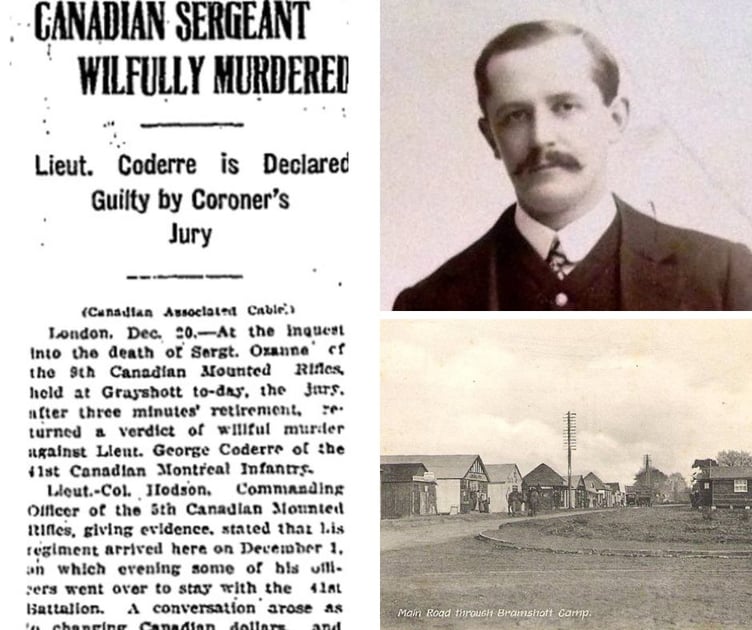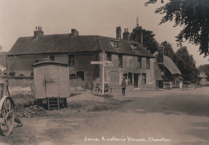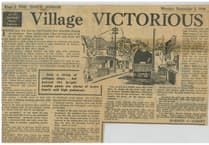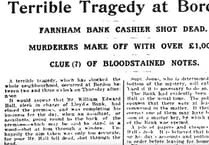A few weeks ago, Peeps into the Past recounted the bloody tale of Bordon bank clerk William Hall, murdered at the hands of Lance Corporal Abraham ‘Jack’ Goldenberg in 1924. But this is not the only bloody episode in the history of the area’s army camps.
Rewind to December 1915. The Great War had started that August and Canada had sent troops to Britain to help in her fight against Germany. One such body of troops was the 41st (Montreal) Canadian Infantry.
The troops were undergoing training at Bramshott Camp before being sent to the Western Front, while officers were billeted at Chase House in Crossways Road, Hindhead.
One such officer, the Acting Adjutant, was Lieutenant Georges Codère.
Codère had a chequered history, and was known as ‘Fou (Crazy) Codère’. The nickname was well deserved - and tragically so.
He had already been cautioned in Quebec for reckless driving when, shortly before coming to England, he was thrown out of a vehicle. It was said he had behaved ‘oddly’ ever since.
There is a good chance, in hindsight, that Codère had suffered a brain injury, which could explain his murderous behaviour upon arriving at Bramshott.
Another new arrival in the camp, Sergeant Henry Ozanne of the 9th Canadian Mounted Rifles, had sought Codère’s help to exchange the regimental canteen funds from Canadian dollars into Sterling, and handed Codère about $1,500 in Canadian money.
However, the deal went sour after Ozanne refused to cover for Codère’s theft of some of the cash.
Codère, fearing he would be court-martialed, offered another sergeant of the same regiment £50 if he would “make a man disappear” by hitting him over the head with a weighted trench stick,
The sergeant, believing he was humouring a lunatic, suggested poison instead.
Codère may have previously attempted to poison Ozanne by putting some white substance in his whisky, but on December 8, Ozanne was found dead at Chase House with his head smashed, his throat cut and 45 cuts inflicted to his face.
Codère instructed a batman to help him take the body to the house's stables, but this was to prove Codère’s downfall as the batman told the Commanding Officer, and Codère was soon arrested and held at Whitehill Police Station.
He was then hauled before magistrates in Alton just before Christmas, where he was committed for trial at Winchester Assizes.
The trial heard Codère was “quite abnormal mentally, and was not regarded as being responsible for his actions; that he could not carry on a sustained conversation”.
His major said he had never intended to take Codère to France as “he was unable to handle men from the moral or mental point of view”, and evidence was given that Codère showed no emotion when confessing.
There was also evidence that his paternal aunt had been ‘insane’, as had several maternal cousins. And he was reported to have been sent away from an agricultural college in Canada because he was thought not to be ‘compos mentis’.
At his trial, the judge gave the jury three options: they could find Codère either guilty, not guilty or guilty but insane.
On February 5, 1916, the jury retired for 20 minutes and found Codère guilty of murder, and Mr Justice Darling sentenced him to hang.
However, an appeal was lodged on the grounds that Codère was not aware that what he had done was “immoral”, and his sentence was commuted to deportation and penal servitude for life in Canada.
On the day of his funeral Sgt Ozanne's body was escorted from Chase House by members of his family, his regiment and the regimental band. The parade was halted in Crossways Road to allow the trumpeters to play the Last Post.
He was buried, with full military honours, in the old cemetery in The Mount, Guildford, where his grave can still be seen to this day.









Comments
This article has no comments yet. Be the first to leave a comment.